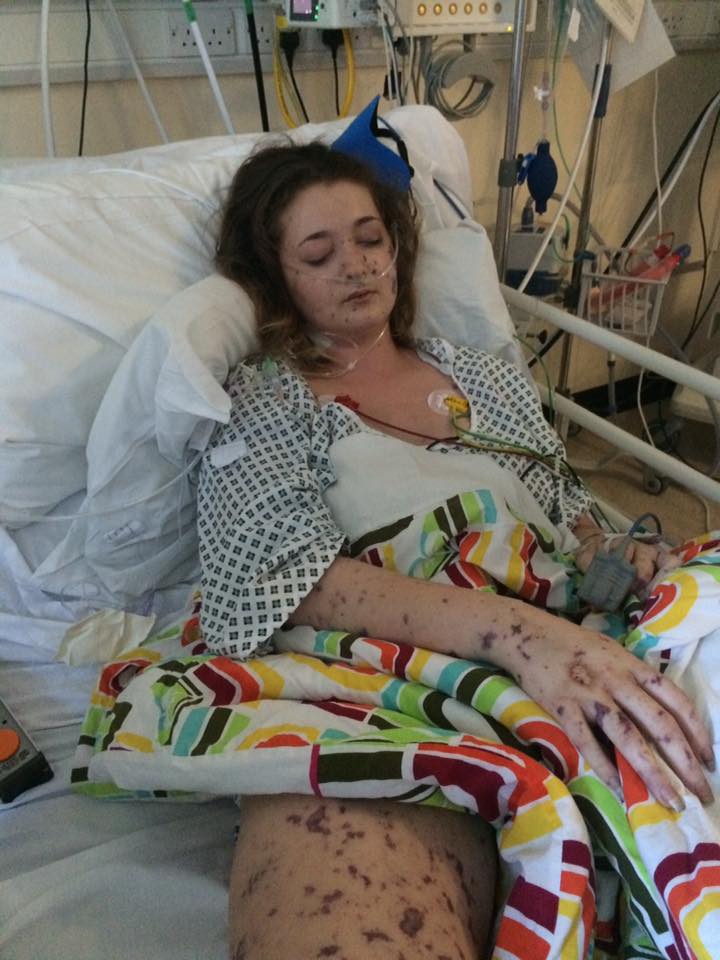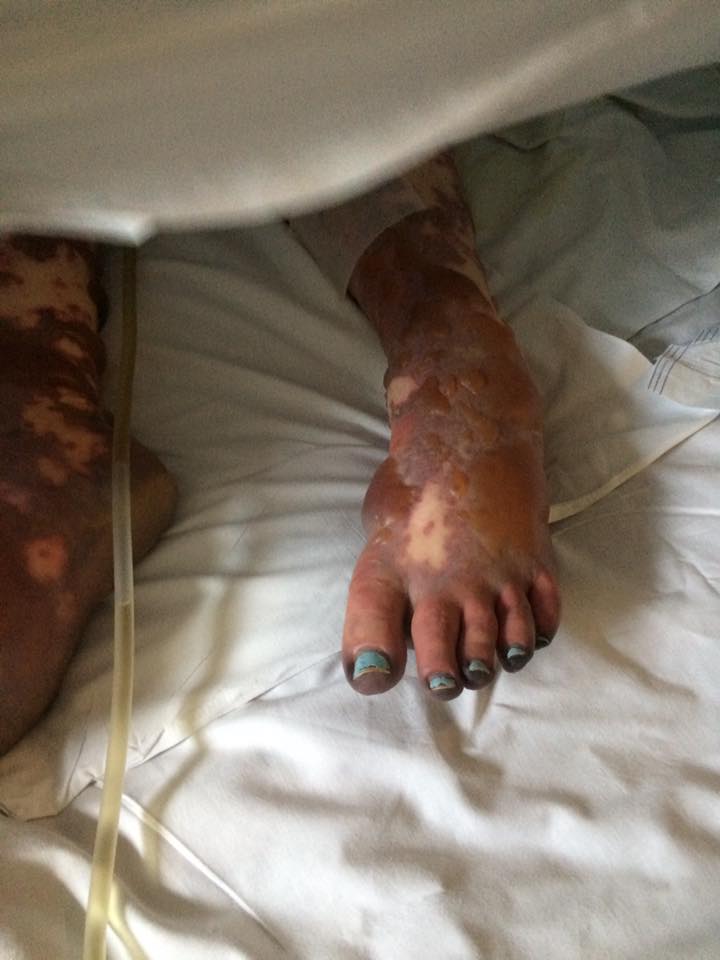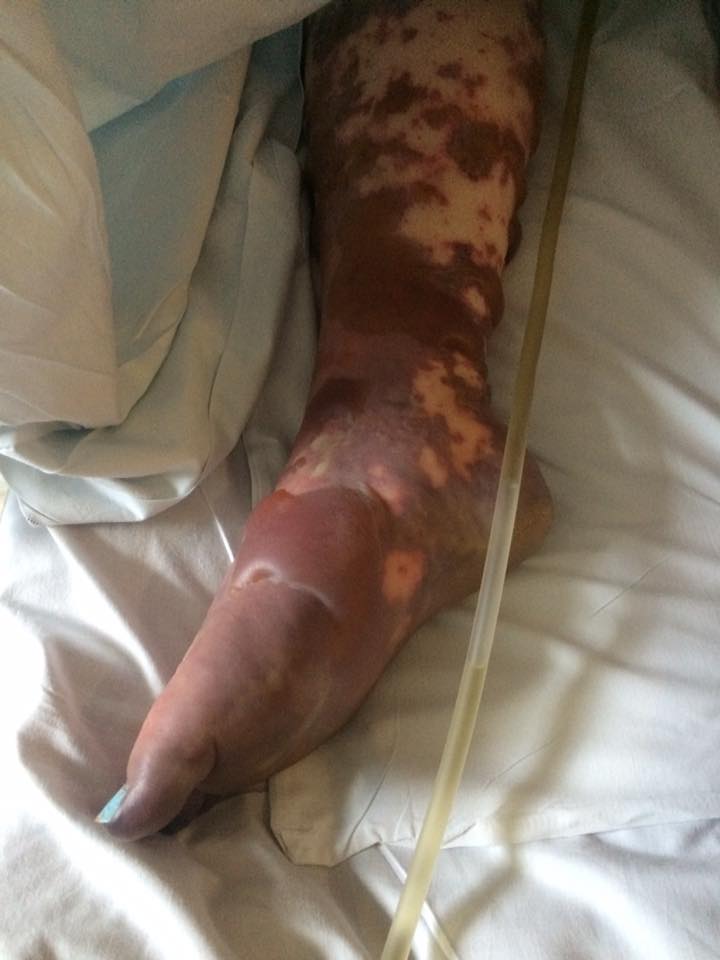*Warning: graphic images and content are below.

Charlene Colechin, a hairdresser from the United Kingdom, knew she was feeling unwell one day in September, but her symptoms didn’t make it seem like she had anything more than a cold.
“She came home from work and started being sick. She also had a headache and, at 9:45 p.m., she called me and asked me to come home,” her mother – Michelle Colechin – told the Derby Telegraph in an interview. According to an interview Charlene gave to The Daily Mail, she was also vomiting.
The 18-year-old figured a bit of rest would help her shake her symptoms, but by the next morning her condition deteriorated; spots began to appear on her neck and fingers, and she began to experience extreme pain.
An ambulance was called, and it wasn’t until paramedics arrived, that anyone knew the teen had contracted a sometimes deadly disease: meningitis.
READ MORE: Alberta meningitis trial: father gets 4 months in jail, mother 3 months house arrest
Since then, Charlene has spent a month in the hospital – nine days of which were spent in a medically-induced coma.
On Oct. 4, she took to Facebook to showcase her current condition.
“These are not nice photos but this is the reality of what meningitis can do,” she wrote of the images that show her in a hospital bed hooked up to tubes and monitors. “I had the worse type of meningitis.”
She went on to describe how her organs failed and that she would have died had it not been for the quick-thinking of doctors.
- Invasive strep: ‘Don’t wait’ to seek care, N.S. woman warns on long road to recovery
- Canadian man dies during Texas Ironman event. His widow wants answers as to why
- ‘Super lice’ are becoming more resistant to chemical shampoos. What to use instead
- Solar eclipse eye damage: More than 160 cases reported in Ontario, Quebec
Speaking to the BBC from Sheffield Hospital, Charlene admits she’s lucky to be alive, even though she faces an incredible uphill battle that will likely result in the loss of her toes and potentially limbs, and has no idea how she contracted the condition.
She says she shared the photos to Facebook to raise awareness about meningitis.
So we thought we’d help get the word out. What do you need to know about this sometimes deadly condition, and who’s most at risk of contracting it? Read on to find out.
Meningitis 101
According to the Mayo Clinic, “Meningitis is an inflammation of the membranes (meninges) surrounding your brain and spinal cord.” It’s spread through close contact (think kissing, sharing food/drink/utensils, etc.) with an infected party, and, interestingly, the disease is only carried by humans.
There are two forms of the disease: bacterial and viral.
The former, which Charlene is suffering from, is far more common; it’s also more severe because the germs responsible can lead to septicaemia (a.k.a. blood poisoning). There are also several bacterial strains of meningitis (Meningococcus, Pneumococcus, Haemophilus B (Hib), Group B Streptococcus (most common in babies less than three months of age), and E. coli), which makes it more difficult to treat.
READ MORE: Canadian family who lost daughter to meningitis shares tragic story to raise awareness
Cases of viral meningitis commonly pop up in the summer and fall, according to the Meningitis Research Foundation of Canada, and most people recover from the condition within five to 10 days.
That’s a stark difference from the stats facing those who contract the bacterial variation of the disease. The CDC reports about 4,100 cases of bacterial meningitis were diagnosed in the U.S. between 2003 and 2007; 500 sufferers died. (Canadian statistics were not immediately available.)
And according to Meningitis Now, a third of survivors will be left with lifelong after-effects such as hearing loss, epilepsy, limb loss and/or learning difficulties.
Who does it impact? Those with compromised immune systems – people suffering from AIDS, cancer, diabetes or those undergoing organ transplant – are most susceptible to developing the disease. As are pregnant women and college students or folks living in close quarters.
What are the symptoms? The most confusing thing about meningitis is its symptoms initially mimic those of other conditions, like a cold or the flu. Early symptoms, which occur within the first six hours, include fever, headache, irritability or nausea. From there, sufferers will begin to feel drowsy, experience muscle aches, leg pain or cold hands and feet. A rash will begin to appear after about 12 hours, and sufferers may start to feel increasingly disoriented (they may also slip into a coma).
READ MORE: Vaxxed producers interview Lethbridge parents found guilty in meningitis death
How is it treated? While viral meningitis can’t be cured with antibiotics (treatment involves bed rest, drinking fluids and taking over-the-counter pain medications), the bacterial variety requires immediate treatment with intravenous antibiotics and, in severe cases, surgery.
Can meningitis be prevented? Mostly, yes. There are vaccines available that can help prevent the development and transmission of the disease. The Government of Canada recommends healthy children receive the vaccine at 12 months of age; a second dose should be administered to children around the age of 12 to bolster immunity. Based on a study from 2011, the preventative measure is effective 87.4 per cent of the time.
And according to 2013 numbers, the meningitis vaccine remains one of the most commonly accepted by parents in Canada. About 88.6 per cent of babies received the first dose of the vaccine within an appropriate timeline (this is in contrast to other vaccinations that many parents are opting out of – like the MMR (measles, mumps and rubella) shot).











Comments